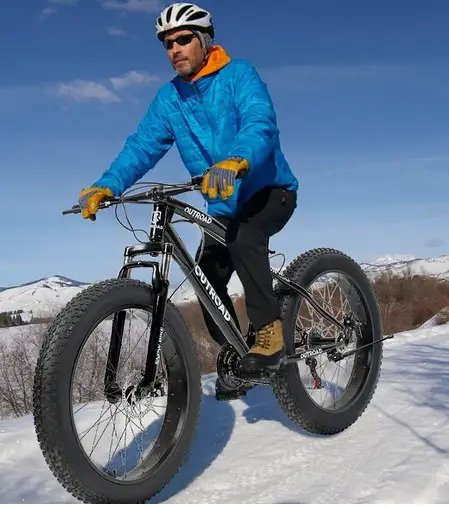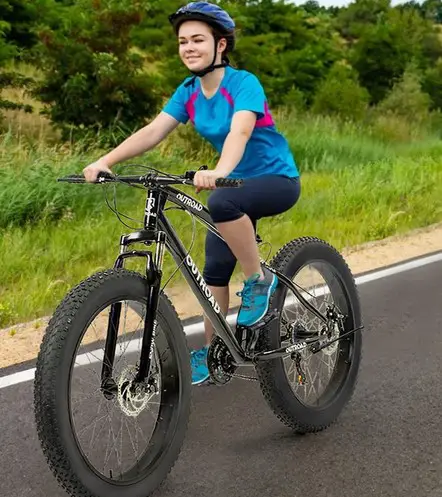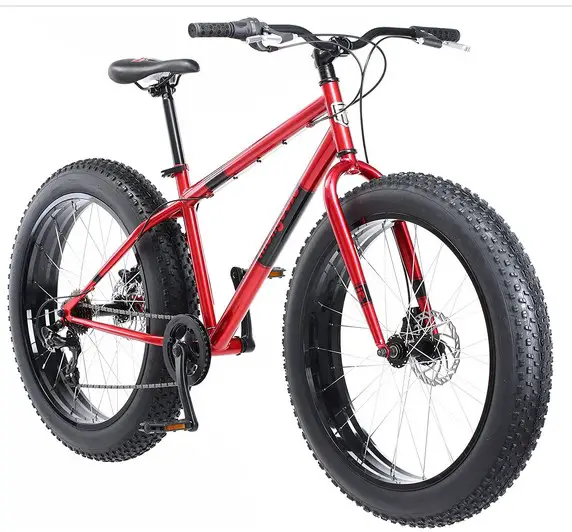They are comfortable, easy to ride, fun, adventurous, have a unique appearance, and can transverse over various terrains, but do fat tire bikes hold more weight?
Fat tire bikes can support more weight because it has a broader pressure range on their tires. Most of these bicycles’ listed weight limit is 300 lbs. While you can go slightly higher than your bike’s limit, do not overexert it.
Fat tire bikes come in different styles, such as mountain bikes and road bikes. It can be a standard bike with thick tires or a mountain bike that has fat tires.

Do Fat Tire Bikes Hold More Weight? Are Fat Bikes Good For Heavy Riders?
Tires directly influence how much weight a bike can hold. Fat tires are better equipped to carry more weight than regular tires because of the following reasons.
1. Construction Material
Fat tire bikes are built to support more weight using sturdy materials such as steel over the aluminum to make the wheel’s spokes and the rim. a good example is the Max4out Fat Tire Mountain Bike (View on Amazon) that’s made of carbon steel, which makes it a stable, durable cruising bike.
Heavy riders often pick fat bikes made of steel, aluminum, or carbon. However, steel is the most preferred choice because it’s more durable, heavier, and stronger.
High-end carbon and aluminum fat bikes can also serve you well with carbon having a slight advantage over aluminum owing to the improvements made to make it robust and carry more weight.
2. Wide Ground Contact
Fat tires are wider hence have a larger area touching the ground. This gives these tires better weight distribution, making them more comfortable and stable, which minimizes crashing.
3. Low Tire Pressure
Fat tires have low pressure which creates more surface area, dispersing weight and keeping the bicycle on top of smooth terrain, like sand.
While there are numerous reasons to ride a fat tire bike, many heavier riders go for them because they offer a means to ride bicycles with confidence.
With a fat tire bike, weight should not hinder you from riding to your favorite places. However, make sure you verify both tires and the frame’s weight limits.
Additionally, consider the weight ratio when identifying if your fat tire can handle your weight comfortably. I will get into the specifics of weight ratio further into this article.
How Much Weight Can A Fat Bike Hold?
With most bikes designed for riders who weigh 200 lbs or less, it is not easy for heavier riders to find a bicycle that suits them. While you can find a standard bike that can handle more weight, fat tire bikes are the first to completely embrace heavier cyclists.
As I mentioned at the start of this article, most fat tire bikes’ listed weight is about 300 pounds. However, some can handle about 200 pounds on each tire, translating to a total of 400 pounds like Vifucz Big Fat Tire Mountain Bike with supersized knobby tires for all-terrains and a maximum weight limit of 440 pounds.
Sometimes, the manufacturer indicates the weight limit for each tire, but since bikes have two tires, each carries a portion of the weight put on the bicycle.
In most cases, the front tires hold 40% of the total weight, while the rear tear supports 60%. However, this depends on the way the bike’s seat is placed.

The weight on your bike can quickly get to 300 pounds or even more during your commute, even if you way considerably less. If you bring along your rack, backpack, and other things, the total weight on your bike will go substantially high.
Going slightly above the weight limit shouldn’t be much of a big deal if you are a casual rider.
The fat tires will distribute the weight well. However, do not underinflate them because it can make the tires flex too much, flatten out, rendering them ineffective.
When you go beyond your fat bike’s weight limit, be cautious not to exert the other parts. You can gradually push the bike from time to time as that will inform you how much wiggle room you have.
What Should Look For In A Fat Tire Bike?
It will be easier to pick a fat tire bike that’s future-proof and functions well if you know the essential features. Consider the following during your selection process.
1. Tire Width And Bike Axle
The widest tires are better for riding on soft sand or snow as you’ll get the maximum traction and float. Therefore, get a fat tire bike with sufficient wheel dropout spacing.
If you want to use tires larger than 4-inches, the rear dropouts need about 190 to 197mm spacing between them, while the dropouts on the front fork need 150mm.
2. Tube Or Tubeless Tires
Fat bike tires are more long-lasting than regular tires; hence, they can withstand abrasion and puncture better. However, the durability of these tires varies based on whether they are tubeless or tube.
Fat tires with tubes last longer than tubeless. Nonetheless, fat tubeless tires can help you lower weight, so there an argument for choosing them.
3. Fat Tire Bike Sizing
Although a fat tire bike offers more wiggle room than you’d even need on a well-suited road bicycle, you must make sure the model you get fits your riding needs and position. Since these bikes have taller tires, they stand higher, which is beneficial for shorter riders.
Most carbon fiber-framed fat tire bikes come in sizes 3 to 4. Nonetheless, some premium aluminum-framed models provide more sizing choices.
4. Frame Geometry
A fat tire bike’s frame is fundamentally different in order to accommodate the fat tires. Year-round versatility and performance are emphasized when designing the frame.
A suspension fork and progressive geometry make a fat tire bike suitable for both winter and summer use.
On the other hand, if you want a fat bike that has a rigid fork, ensure it has a suspension-ready frame geometry. A good example of such a bike is the Mongoose Dolomite Men’s Fat Tire Mountain Bike (View on Amazon) that’s made with fantastic features that work well together, making it a very versatile machine.

5. Intended Use
How you plan to use your fat tire bike is a factor that you must think about critically. For instance, if you want a bike for winter or potentially year-round use, prioritize features like wheel weight and compatibility and the bike’s suspension.
If you want a fat tire bike you can comfortably ride in the snow, the hosote Fat Tire Men’s Mountain Bike is an excellent choice. You can also ride to the beach and on dirt, mud, and city roads.
The above factors are key determinants of a fat tire bike’s performance, so use them as a guide when shopping.
FAQs
1. Is A Fat Bike Worth It?
Fat bikes are worth it because they are versatile, comfortable, and can handle more weight. When going bikepacking, a fat bike will comfortably carry the essential items you will need during your trip.
In addition, the weight distribution feature that lets fat tire bikes support more weight makes them ideal for riding on various surfaces like snow, sand, and mud that a tire would typically sink. They are also better and safer in winter and wet conditions.
2. What Is A Good Weight For A Fat Bike?
Fat tire bikes’ base models weigh around 35-36 pounds, and premium models are below 30 pounds, while custom-built options can be as low as 22 pounds. Fat bikes weigh considerably more compared to regular bikes because they have larger rims, tubes, and tires.
3. What Is Considered A Fat Tire?
Fat tires’ size range is about 3.7 inches to 5.2 inches and usually mounted to 50mm to 100 mm rims. Narrower ones are best for groomed racing and snow riding, lighter riders who need less floatation, and desert tracks tours.
The widest tires are suitable for desert expeditions, soft snow, bigger cyclists who need more support, or backcountry beach.
4. Can You Put Fat Tires On Any Bike?
Fat tires can only be used on fat tire bikes. However, you can raise the tires’ width by a certain extent, but you must account for the rim’s width and the fork’s clearance.
In Conclusion, Do Fat Tire Bikes Hold More Weight?
They certainly do, which is why they are perfect for riders who weigh more or if you tend to carry more luggage often. It would be in your best interest to ascertain the weight of a fat tire bike before buying.
Since fat tire bikes hold more weight, heavier riders can use them to lose weight. Riding using a fat tire bike presents an excellent way to burn calories because it takes more energy to have big tires going and sustain the speed. You will use more effort to ride a fat bike than a mountain bike.
You can take up fat riding to lose weight or improve your fitness. It can significantly improve your stamina and strength.
